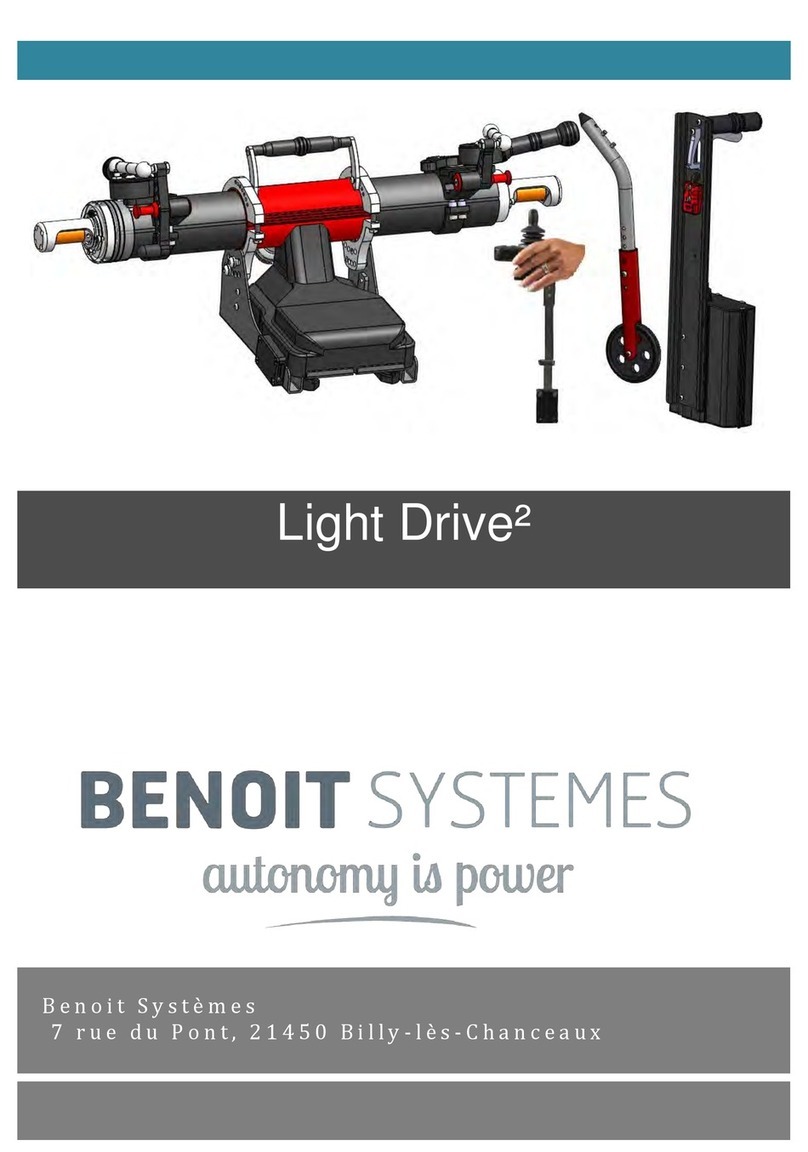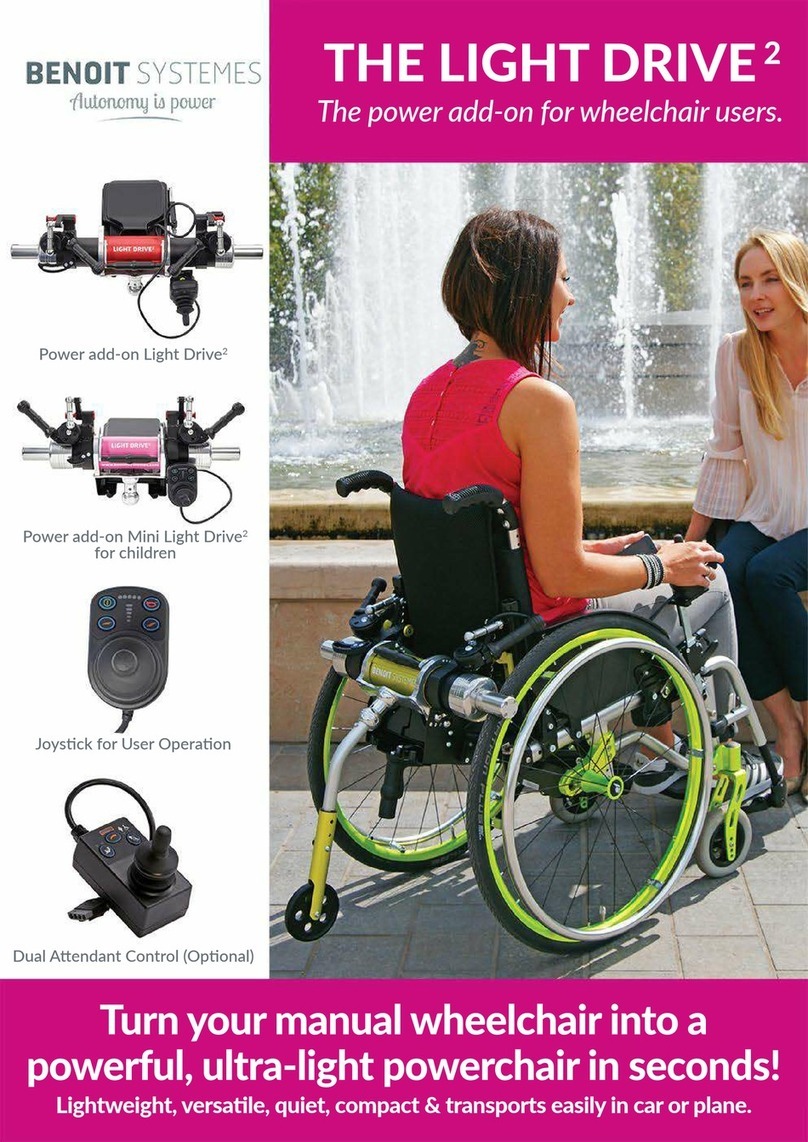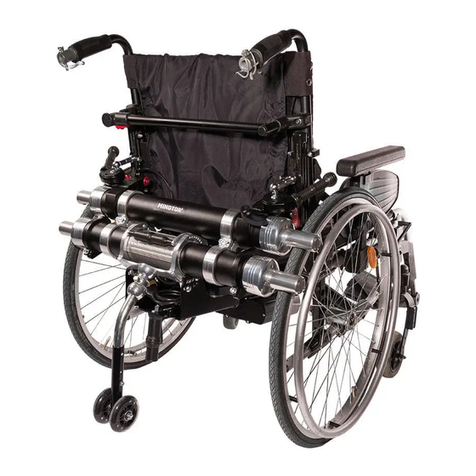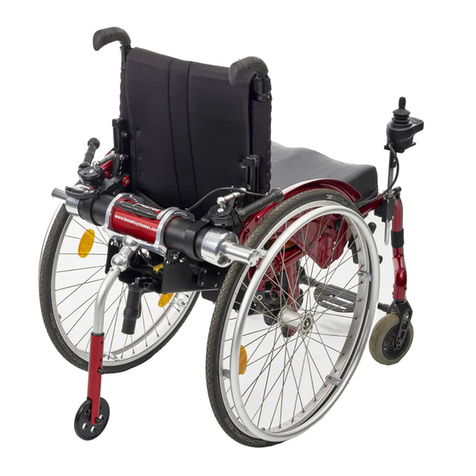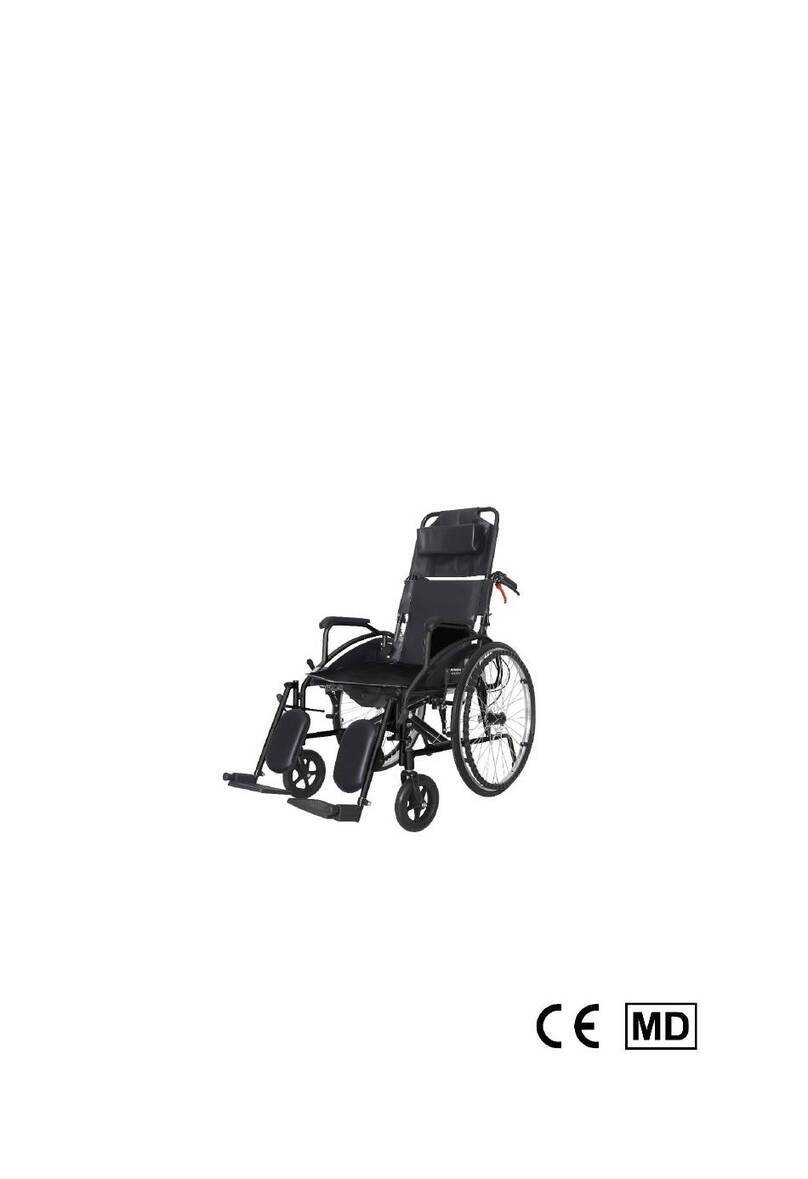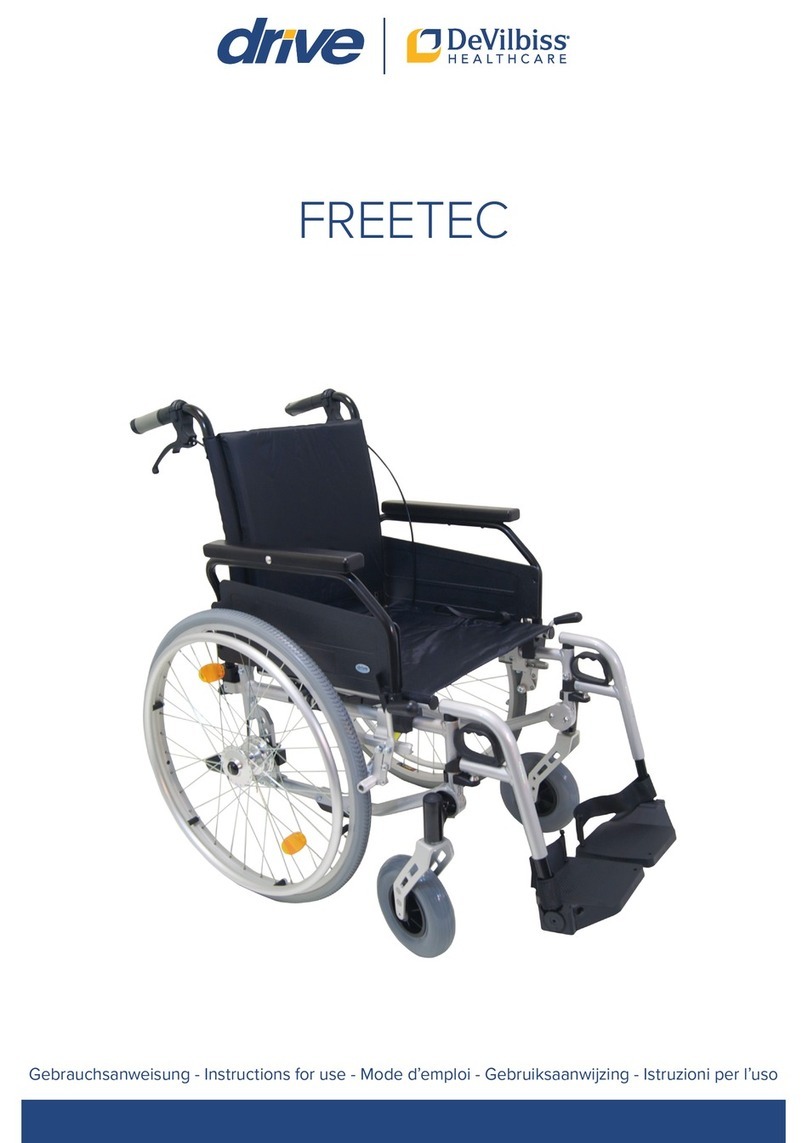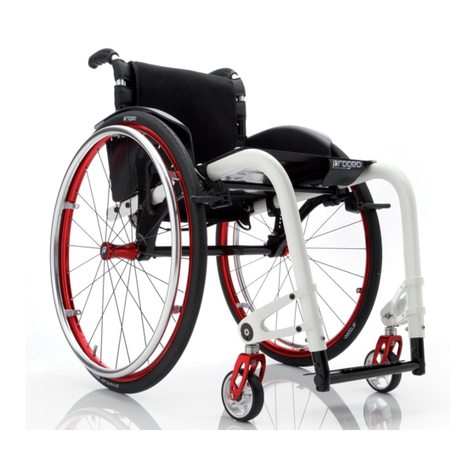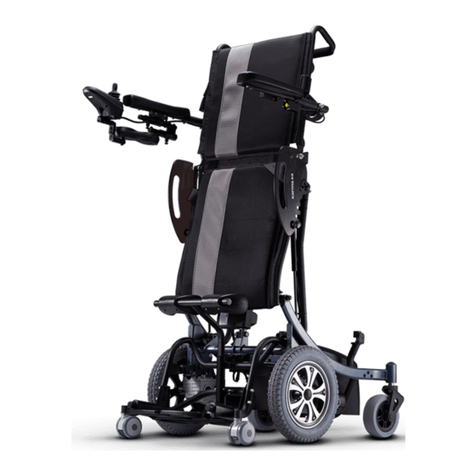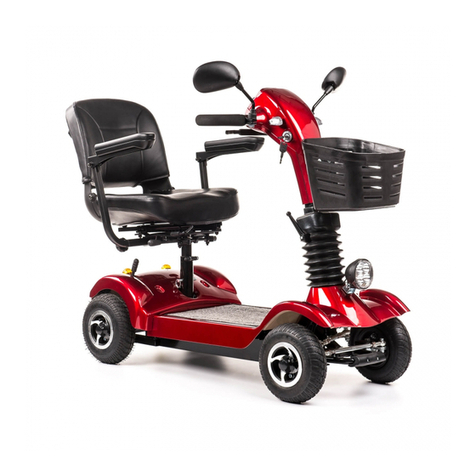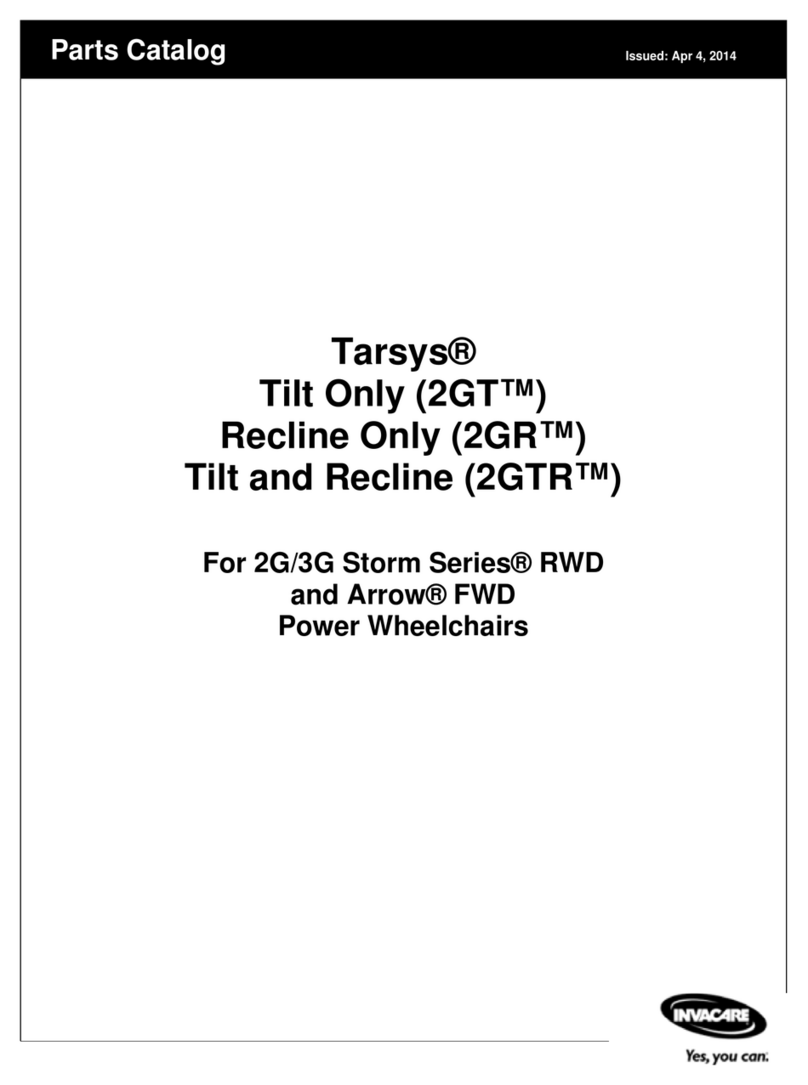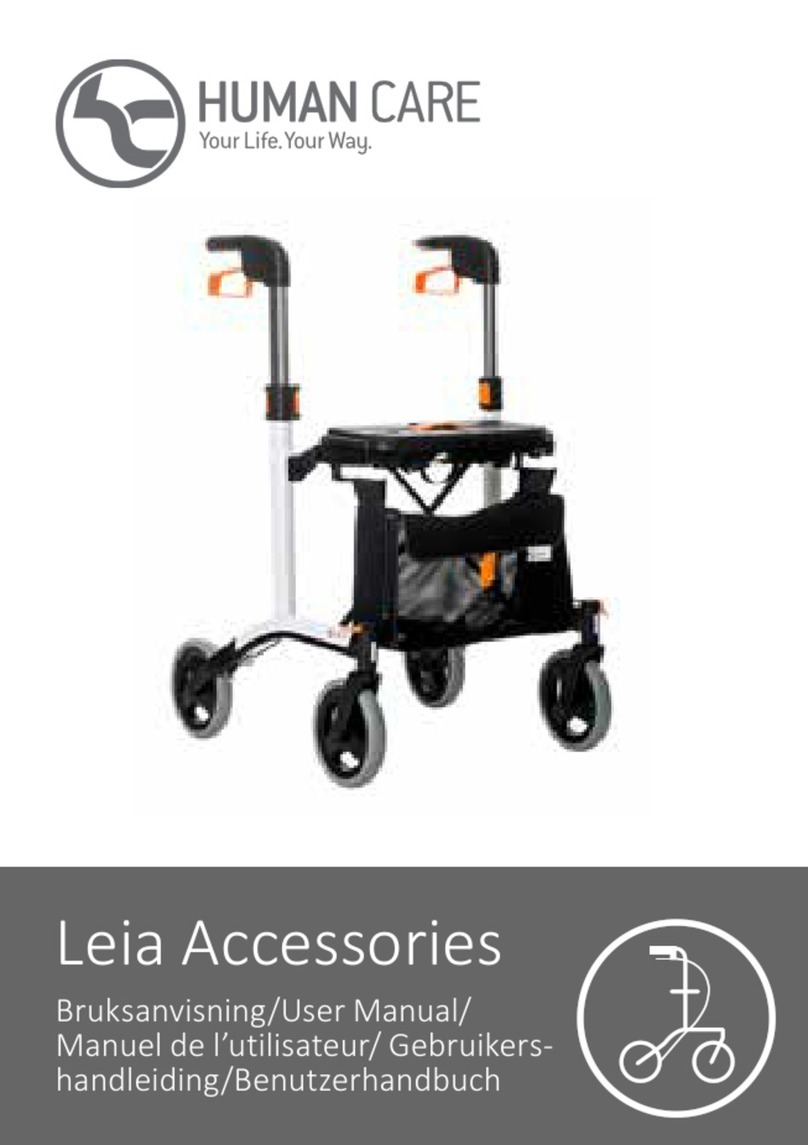BENOIT SYSTEMS LIGHT ASSIST 2.1 User manual

2 3
The Light Assist 2.1 is an aid to pushing and braking the manual wheelchair that should only be used by
the person accompanying the user. This lightweight power add-on transforms a manual wheelchair into
an electric wheelchair.
For safety reasons, the Light Assist 2.1 should only be used by people who:
• have been told how to handle it,
• are mentally and physically able to use a control unit to operate the motorised wheelchair and its
functions.
The user and their carer must follow general safety and use instructions. As a producer,
Benoit Systemes reserves the right to change the product specications without prior notice.
In this manual, hazard statements are indicated by symbols. These symbols are accompanied by a
warning indicating the risk level.
WARNING
Indicates a dangerous situation that, if not avoided, is likely to cause severe or even fatal injuries.
CAUTION
Indicates a hazardous situation that, if not avoided, is likely to cause in minor or slight injuries.
Gives advice, recommendations and useful information for efcient, problem-free use.
The required conditions must take into account all the factors for which the Light Assist 2.1 device
provides a relevant response. An MPR Doctor (Médecine Physique et de Réadaptation, Physical and
Rehabilitation Medicine), assisted by an occupational therapist or physiotherapist, will assess the
suitability of the adaptable comfort solution for the patient’s condition and their capabilities, their
environment and their physical and cognitive capacities.
For any question about the use, servicing or safety of your equipment, contact your dealer.
Please avoid using the Light Assist 2.1 before receiving instrucons about the equipment from an
approved dealer.
INTENDED USE
INDICATIONS
SYMBOLS USED IN THIS MANUAL
MEANING OF SYMBOLS APPEARING ON THE LABELS
GENERAL REMARKS
120 Kg 10 Km/h
SN
MADE IN FRANCE
LIGHT ASSIST2.1
7, rue du Pont
21450 BILLY LES CHANCEAUX
www.benoitsystemes.com
Ne pas immerger la batterie
dans un liquide
Do not immerse in any liquid
Ne pas exposer à des ammes
ou à une température
supérieure à 50°C
Do not expose to ames or
temperatures exceeding 50°C
/ 122°F
Utiliser uniquement le
chargeur Benoit Systèmes
Only use the Benoit Systemes
Charger
Ne pas percer ni tarauder
Do not drill and no thread
Ne pas utiliser d’autres vis
que celles fournies
Do not use others screws than
those supplied
Benoit Systemes considers a service life of ve years as long as the product is used for its intended
purpose and obeying use, safety and maintenance instructions. However, this service life can be
exceeded when the product is serviced and maintained carefully and used cautiously, appropriate to its
technical specications.
The service life may also be considerably shortened following extreme or inappropriate use. The service
life set by our company does not constitute an additional guarantee.
SERVICE LIFE
Read the instrucons for use carefully – indicates the need
for the user to read the user instructions and safety guidance
carefully
Date of manufacture DD/MM/YYYY
Serial number. The motor drive serial number is located under
the motor drive, in the place where you slide the battery
Baery life / Maximum range
Maximum user weight
Maximum speed
Keep dry
This product has been supplied by a manufacturer aware of
environmental issues. This product may contain substances
harmful to the environment if it is discarded in a place [of
exchange] contravening current legislaon.
▪ The ‘crossed-out wheelie bin’ symbol is applied to this
product to encourage recycling when possible.
▪ Preserve the environment by having this product recycled
at a recycling centre at the end of its life.
The company manufacturing the packaging materials has
paid a royalty to Eco-Emballage
In compliance with the European RoHS Direcve, for
‘Restricon of the use of certain Hazardous Substances’,
intended to reduce the use of hazardous substances in the
manufacture of electronic equipment.
CE marking in compliance with Annex V of European
Regulaon 2017/745/EEC

4 5
WARNING
It is prohibited to modify this equipment without the producer’s authorisation.
GENERAL ASSEMBLY VIEW OF THE power add-on
TECHNICAL SPECIFICATIONS
Lithium battery 12Ah 297Wh
Weight 3.85 kg
Range* 15 to 18 km
Charging time 5-6h When the battery is empty
Service life 1000 cycles
Weight of the power add-on 8,8 kg
Maximum weight of the user*120 kg
Maximum permitted weight for the equipment
(weight of wheelchair + weight of user, excluding
weight of the equipment)
150 kg
Maximum speed 10 kph, programmable
Power of motors 2 motors, 130 W with brakes
Maximum safe slope 5° (9%)
Maximum crossable obstacle height 2.5 cm (without run-up) – 7 cm (with run-up)
Range** 15 to 18 km
Suitable wheelchairs*** Compatible with most manual wheelchairs
* If you exceed this limit, you might damage the frame or fastenings of your equipment, which could cause serious
injuries for you or someone else.
** Battery life can vary depending on the temperature, the person’s weight and the type of ground.
*** A compatibility guide is available to know the wheelchair models on which the Light Assist 2.1 can be installed,
in compliance with the general safety and performance requirements set out in European Regulation 2017/745 on
medical devices.
SPECIFICATIONS OF THE LIGHT OF THE Light Assist 2.1...............................5
General assembly view of the power unit.............................................................................. 5
Technical specicaons.............................................................................................................. 5
Components.................................................................................................................................. 5
SERVICING AND MAINTENANCE .................................................................. 8
Servicing the equipment ............................................................................................................ 8
Performance checks.................................................................................................................... 8
Waste management .................................................................................................................... 9
Troubleshoong .........................................................................................................................10
TRANSPORT AND STORAGE.......................................................................11
SAFETY AND HAZARD INSTRUCTIONS ........................................................13
General safety instrucons......................................................................................................13
Safety informaon about the electrical system..................................................................14
Safety recommendaons about electromagnec compability.....................................15
Safety informaon about installaon....................................................................................15
Safety informaon about driving ...........................................................................................16
Safety informaon about servicing and maintenance.......................................................17
Safety informaon about modicaons made to the equipment ..................................17
Safety informaon about using the baery and charger..................................................18
Important informaon about the maintenance tools........................................................19
GUARANTEE ............................................................................................20
Terms & condions....................................................................................................................20
Limits of liability’s ......................................................................................................................20
Checks performed .....................................................................................................................20
Contents SPECIFICATIONS OF THE LIGHT ASSIST 2.1
COMPONENTS
Comprises two electric motors tted with the transmission,
mechanisms making the connection between the wheelchair
interface and nally the battery slider.
The Light Assist 2.1 consists of several components:
THE MOTOR TUBE
Comprising a 12 Ah LITHIUM BATTERY mounted on
a support rack that enables installation and automatic
connection to the motor subassembly.
The power add-on is supplied charged. Unless the battery
is transported by air, when it is supplied uncharged. In
this case, before using your equipment for the rst time,
you have to charge the battery for 8 hours.
* Battery life can vary depending on the temperature, the person’s weight and the type of ground.
ELECTRICITY SUPPLY

6 7
CONTROL HANDLES
The wheelchair tted with a power add-on keeps its initial balance. But the power of the motors, if
badly controlled on slopes, can make the wheelchair tip over. The anti-tip fulls its role effectively
while allowing obstacles to be crossed. It must always be tted (small wheel downwards). This has been
adjusted by your installer to guarantee safe driving.
All the travel functions of the Light Assist 2.1 are operated by the control handles. Two
handles are supplied with the power add-on:
• one throttle handle
• one static handle
The handles (throttle and static) are positioned to right or left on the rear handles of the
wheelchair and are locked in place.
Benoit Systemes waives all liability if an accident occurs while the anti-tip is not tted.
ANTI-TIP
STATIC HANDLE
It balances the other person’s arms. The
xed handle is placed at the rear of the
wheelchair and is locked in place
THROTTLE HANDLE
Start/Stop button
o
f
f
o
n
Forwards/Backwards Speed limiter
Before making your rst journey, you should familiarise yourself with operation of the electric vehicle
and all the accessories. Take your time to test all the functions and driving modes.
PROPERLY SEATED = SAFE DRIVING
Before each journey, check that:
• The user is posioned safely in their wheelchair (wearing a seatbelt, if necessary).
• The baery suciently charged for the journey you’re planning to make.
• The safety an-p is inserted into the rear handle. Check the mounng direcon (small wheel
downwards) and that the locking pin is securely ed.
OPERATE USING THESE CONTROL HANDLES
Press the ‘Start/Stop’ button to set the Light Assist 2.1 in motion.
Turn the handle to go forwards or backwards depending on the position of the Forwards/Backwards
button. If you wish, adjust your speed using the speed limiter button by rotating it slowly until the desired
speed is reached.
For a pleasant journey, adjust the speed to suit your own pace. Release the throttle handle to stop the
Light Assist 2.1.
Approaching a pavement:
Don’t stop in front of the step and don’t try to lift the wheelchair!
Approach the pavement slowly, tip the wheelchair (front wheels on the pavement) and continue
moving forward.
In confined spaces, there are 2 possibilities:
1. Disengage the power add-on and use the wheelchair in manual mode.
2. Use the speed limiter to lock the power add-on at a very slow speed and drive the wheelchair
using the throttle handle.
RECOMMENDATIONS FOR USE
A 24 V MASCOT
CHARGER is supplied
with the baery
As an option: The 24 V MASCOT
charger for Special Car Lithium
Batteries (with cigarette lighter
socket)
Only use original batteries. We decline all liability for damage caused by using other batteries
not supplied by us.
DRIVING PRACTICES
Disengage the power unit in a
single movement and so restore
convenonal use of the wheelchair Disengage the left handle and bring it slightly forward.
Disengage and bring the right handle against the seat back.
1
2
1 2
The

8 9
• The equipment’s packaging goes to recycled materials.
• The metal parts go to old metal recycling.
• The plastic parts go to plastic recycling.
• The electrical parts and printed circuits go to electronic waste.
• Worn out or damaged batteries are taken back by your medical equipment shop or by Benoit
Systemes.
• Waste should be managed in accordance with the appropriate national legal requirements in force.
• Ask your local authority for information about suitable local rms.
The Light Assist 2.1 is equipment requiring very little maintenance. However, your equipment should
undergo a technical safety check at least every 2 years, performed by a specialist who will check if it is
fully functional and safe. This check will detect any unseen damage caused by using the system, as well
as wear and fatigue phenomena. To this end, please make direct contract with your Benoit Systemes
approved dealer.
Correct servicing will improve your vehicle’s performance and extend its service life, as well as reducing
the risk of an accident.
WASTE MANAGEMENT
Servicing and inspection programme Daily* Monthly Quarterly Annually
Check that all the parts and devices are firmly attached
Inspect the condition of the tyres and wheel fastenings
Check that the cables and connectors are in good condition, are
not tangled and are not in the way.
Inspect the condition of the seat you use
Inspect all the bolts, nuts and fastenings to confirm they are not
damaged or loose. Contact your dealer.
Check that the battery terminals are tightened
Full inspection, safety check and service performed by a Benoit
Systemes approved dealer
* Every day, before each use
The user should regularly check the condition of the equipment to ensure it is used safely.
After having cleaned or repaired the vehicle, you must always check it is working correctly before using
it.
Visually inspect the vehicle to check that the footrests, seat, etc. are correctly positioned and rmly
attached to the wheelchair and that all fastenings are tightened sufciently.
It is recommended that the items shown in the table are inspected at the stated intervals.
Your approved dealer should repair or replace loose, worn, distorted or damaged parts before using your
vehicle.
• Before undertaking any cleaning, ensure the equipment is turned off.
• Clean the rollers and their housing regularly with a screwdriver.
• Once a week, run a vacuum cleaner around the motor, to remove all accumulated dust.
• Clean the entire power add-on with a damp (not wet) cloth.
• Clean the electrical components with clean, dry cloths that are neither wet nor damp.
• Clean the control handles using a cloth moistened with dilute detergent.
• Never use abrasive or alcohol-based detergents.
• Remember to wipe the equipment if it is wet or damp, after having cleaned it or if it has picked up water
or moisture while you were using it.
PERFORMANCE CHECKS
SERVICING THE EQUIPMENT
CAUTION
It is important to follow the servicing and mainte-
nance programme for the equipment to keep it in
good condition.
CAUTION
If in doubt about the performance of your vehicle, contact your approved dealer.
WARNING
If you’re not sure you can service your equipment
yourself, contact your approved dealer.
WARNING
Inate the tyres to between 6 and 8 bar
It is better to have a tyre inflated without knowing the exact pressure that to have a deflated tyre.
Keep your wheelchair fitted with good quality tyres. Contact your dealer if you cannot find the same
tyres as those we have fitted (Schwalbe tyres, Marathon Plus or PrimoSentinel).
Never replace the pneumatic tyres with solid tyres.
A video is available on the Benoit Systemes YouTube channel under the name "Les pneus".
WARNING
Never wash your wheelchair using a hose or pressure washer. Only use common household cleaning and
disinfection products.
FOR OPTIMUM USE OF THE PRODUCT,
find our explanatory videos on The Benoit Systemes YouTube channel
SERVICING AND MAINTENANCE

10 11
TRANSPORT
By air
The 12 Ah Lithium battery meets the require-
ments of the current IATA regulations. If you have
to travel by air, ensure you contact the airline. The
battery certicate can be viewed on our website
on the documentation page.
Recharging batteries in foreign countries:
• Item to consider: the type of plug.
• Ensure you have an adaptor to t between the
wall socket and the plug on your charger. Find out
about the type you require.
CAUTION
Before making your journey, contact the carrier.
The organiser will provide information about any
specic conditions/instructions.
Check that the removable parts of the equipment
are securely attached or separately packed and la-
belled to avoid them being mislaid during loading
and unloading.
Take this manual with you.
By car
The Light Assist 2.1 can remain tted to the wheel-
chair during transport, but the battery rack should
be removed and stored safely.
The control unit and battery rack should not be
connected during transport.
If the Light Assist 2.1 is taken off the wheelchair,
ensure that it is secured in the vehicle to avoid any
danger for the vehicle’s occupants when braking.
The different components of the equipment must
be stowed safely.
Ensure that all the components are kept during
transport or storage at a safe and especially a
clean place.
Under no circumstances should metal particles or
other small items get into the electrical connec-
tions. The electrical connections must be cleaned
using compressed air before being assembled, to
prevent any contaminants causing a short-circuit.
CAUTION
If accidents and/or damage on the wheelchair or
the Light Assist 2.1, arising from failure to follow
these instructions, and/or current requirements
in your country, or that are attributed to the use
of an unauthorised or unsuitable safety system,
Benoit Systemes and its representatives refuses
to accept any liability.
STORAGE
If the motorised vehicle is not used for a prolonged
period (more than a week), you should prepare it
for storage in order to extend its service life and
the battery lifetime.
Follow these instrucons:
• We recommend storing the motorised vehicle
at a temperature of 15°C and avoid extreme
temperatures in order to extend the service
life of the vehicle and batteries.
• The components are tested and approved for
greater temperature ranges, described below:
* The range of temperatures per-
mitted for storing the motorised
vehicle is between –40°C and +50°C.
* The range of temperatures permitted for
storing the batteries is between –25°C and
+50°C.
• The batteries must always be fully charged be-
fore being put into storage.
• For prolonged storage, the battery rack must
be connected to the charger supplied every 3
months and fully recharged, to guarantee the
operating capacity of the equipment.
• Store them in a dry, well-ventilated environ-
ment protected from outside inuences.
• The battery used is lithium-ion type that, if
handled correctly, does not leak and is main-
tenance-free.
WARNING
Never store your equipment:
• Outdoors.
• In direct light (the plastic components can dis-
colour).
• Close to a source of direct heat.
• In a damp environment.
• In a cold environment.
• With the batteries/battery units connected
(even if the control unit is turned off).
This diagnosis is only for guidance but in the event of a problem, contact your Benoit Systemes
approved dealer.
TROUBLESHOOTING
The tyre treads wear rapidly.
Possible causes Soluons
Poor quality tyres Fit good tyres
Tyres under-inated Inate the tyres to between 5 and 8 bar
Insucient pressure of the rollers on the tyres Adjust the pressure
The tyre is worn on the inner wall
Possible causes Soluons
The roller cover is touching the tyre Contact your dealer
The bracket for the wheelchair wheel is loose Tighten this bracket correctly
The wheelchair goes in a circle
Possible causes Soluons
A brake of the wheelchair is on Release it
A motor is faulty Contact your dealer
The power add-on is making noise
Possible causes Soluons
Part of the wheelchair is touching a wheel Visually check the condion of the wheelchair
A motor is faulty Contact your dealer
A bearing is faulty Contact your dealer
A roller cover is touching the tyre Contact your dealer
A clutch handle is not staying engaged
Possible causes Soluons
Incorrect adjustment of the ball joints Contact your dealer
Distoron (following an impact or other shock, etc.)
Contact your dealer
The baery rack is not supplying current
Possible causes Soluons
Baery discharged Charge it
Charger faulty Contact your dealer
A connecon is faulty Check the terminals and connecons
Dilapidated baery Contact your dealer and replace it
TRANSPORT AND STORAGE

12 13
GENERAL SAFETY INSTRUCTIONS
WARNING
Risk of damage to the equipment or serious, even
fatal, injury if the control unit is used incorrectly.
• Undertake a test session with a healthcare
professional before using a joystick.
• If you are not used to control by using a joys-
tick, travel slowly and rst familiarise yourself
with the driving and directional characteris-
tics of the wheelchair on a at, unobstructed
route.
DANGER
Risk of damage to the equipment or serious, even
fatal, injury.
• Dropping lighted cigarettes onto a padded
seating system can start a re likely to cause
damage to the equipment or serious, even fa-
tal, injuries.
• The occupants of a motorised vehicle are
more particularly exposed to a risk of serious
or even fatal injury associated with such res
and the resulting smoke, as they are not always
able to get away from the electric vehicle – Do
not smoke when using this motorised vehicle.
WARNING
Risk of damage to the equipment or serious, even
fatal, injury.
• Inappropriate supervision or servicing are li-
kely to result in damage to the equipment or
serious, even fatal, injuries, following breath-
lessness or ingestion of parts or materials.
• It is essential for children, pets or people with
physical/learning disabilities to be supervised
closely.
• Don’t allow children or anyone else to use
your equipment.
WARNING
Risk of injury if the equipment is used for a purpo-
se other than that described in this manual
• The motorised vehicle must be used in accor-
dance with the manufacturer’s instructions. It
must not be used for a purpose other than that
for which it is designed. Pay special attention
to the safety instructions.
WARNING
Risk of damage or injury if the electric vehicle is
started unintentionally.
• Do NOT sit on the electric vehicle during the
adjustment phase.
• Disconnect the power supply to the electric
vehicle before getting onto it, getting off it or
handling objects.
• The brake disengagement mechanism must
only be used in an emergency situation and if
the power supply is lost.
• Do not push the vehicle by hand when the
brakes are applied and when the power supply
is disconnected.
• Don’t forget to reapply the brakes before put-
ting the vehicle back into use.
WARNING
Risk of falling from the electric vehicle
• Do not move forward on the seat, do not lean
forward and do not stretch backwards beyond
the top of the seat-back, such as to reach an
object.
WARNING
Risk of injury if driving under the inuence of
drugs or alcohol
• Never drive if you are under the inuence
of drugs or alcohol. If necessary, ask for help
from someone else with appropriate physical
and mental abilities.
WARNING
Risk of injury if the contact is broken while the
electric vehicle is moving, such as after operating
the start/stop button or disconnecting a cable,
leading to the vehicle stopping suddenly and vio-
lently
• Never operate the stop button nor disconnect
a cable while the vehicle is moving, except in
an emergency, because it stops suddenly.
• If you have to brake in an emergency, simply
let go of the joystick to stop the vehicle.
SAFETY AND HAZARD INSTRUCTIONS
CAUTION
Aer an extended storage period at low tempe-
rature (–25°C), it is possible for the motor to turn
itself o aer being turned on; this situaon may
persist for about 2 minutes, aer which the pro-
duct funcons normally.
By following the instructions above, you will avoid
complete discharge cycles of the batteries and will
extend the operating life of the batteries when the
equipment is returned to service.

14 15
WARNING
Risk of damage to the equipment or serious injury
• LStoring or using the vehicle close to a naked
ame or ammable products can result in da-
mage to the equipment or serious injuries.
• To ensure the equipment is reliable, avoid ex-
posing it to extreme conditions, heat or humi-
dity.
• Never store your electric vehicle outdoors.
CAUTION
Risk of injury if the maximum permitted load is
exceeded
• Do not exceed the maximum permitted load
(refer to the Technical Specications section).
• The electric vehicle is only designed to accom-
modate a single occupant with a maximum
weight not exceeding the maximum permitted
load for this equipment. Never use the vehicle
to transport several people.
CAUTION
Risk of injury in the event of inappropriate hand-
ling or fall of heavy parts
• during servicing and maintenance operations
or when you are lifting certain parts of the
equipment, consider the weight of each com-
ponent, particularly the batteries. Ensure you
always adopt the correct posture and don’t
hesitate to ask for help.
CAUTION
Risk of injury caused by moving parts
• Ensure that the moving parts of the motorised
vehicle, such as the wheels or joystick, do not
cause injuries, particularly when children are
present.
CAUTION
Risk of re or fault when connecting electrical
equipment
• Do not connect your motorised vehicle to
any equipment that has not been explicitly
permitted by Benoit Systemes. Rely on your
Benoit Systemes approved dealer for all elec-
trical installations.
SAFETY INFORMATION ABOUT THE ELECTRICAL
SYSTEM
WARNING
Risk of damage to the equipment or serious, even
fatal, injury Inappropriate use of the motorised
vehicle can result in the emission of smoke or
sparks, and heat may be given off.
A re is likely to cause damage to the equipment
or serious, even fatal, injuries.
• The motorised vehicle must NOT be used for
a purpose other than that for which it is de-
signed.
• If the vehicle begins to emit smoke, sparks or
heat, stop using it and have it checked IMME-
DIATELY.
WARNING
Risk of injury or damage associated with short-cir-
cuits.
The pins of the connectors tted to the cables
connected to the power module can remain live
even when the system is stopped.
• Cables tted with active pins must be connec-
ted, retained or covered (using non-conduc-
tive materials) so as not to be exposed to hu-
man contact nor to materials likely to cause
short-circuits.
• When cables tted with active pins have to be
disconnected (e.g. to disconnect the bus cable
from the control unit for safety reasons), en-
sure the pins or retained or covered (using
non-conductive materials).
WARNING
Risk of damage to the equipment or serious, even
fatal, injury Corrosion of electrical components
due to exposure to water or liquids can result in
damage to the equipment or serious, even fatal,
injuries.
• Reduce the exposure of electrical components
to water and/or liquids.
• Electrical components damaged by corrosion
MUST be replaced immediately.
• Motorised vehicles frequently exposed to wa-
ter/liquids can require electrical components
to be replaced more frequently.
WARNING
Risk of serious, even fatal, injury
Failure to take note of these warnings can cause
an electrical discharge resulting in serious or fatal
injuries, or damage to the electrical system.
• The POSITIVE (+) RED cable from the battery
MUST be connected to the POSITIVE (+) ter-
minals/poles of the battery.
• The NEGATIVE (–) BLACK cable from the bat-
tery MUST be connected to the NEGATIVE (–)
terminals/poles of the battery.
• Ensure that tools and/or cables are NEVER
in contact with BOTH poles of the battery at
the same time. This could cause an electrical
discharge and damage to the equipment or se-
rious, even fatal, injuries.
• Immediately replace a cable(s) where the in-
sulating cover is damaged, the cable(s) frayed
or the lead(s) cut.
• Do NOT remove the fuse nor the fastenings
for the red POSITIVE (+) cable from the batte-
ry and the tting screw.
CAUTION
Risk of damage to the motorised vehicle
A fault in the electrical system can cause unusual
behaviour.
• In the event of a fault, turn the control unit off
and back on again.
• If the problem persists, disconnect or remove
the battery unit.
• If in doubt or for any question, don’t hesitate
to contact your dealer.
SAFETY RECOMMENDATIONS ABOUT ELECTRO-
MAGNETIC COMPATIBILITY
Electromagnetic elds, such as radio and television
transmitters, radio devices and mobile telephones
produce them, and may have an inuence on the
operation of the vehicle. The electronic device
used in this device can also cause weak electro-
magnetic disturbances, however these are below
the legal limit. Therefore please consider the fol-
lowing comments:
WARNING
Risk of incorrect operation following electro-
magnetic emissions
• Do not use a portable transmitter nor com-
munication devices (radio devices or mobile
telephones) or, as applicable, to not use them
while the electric vehicle is in use.
• Avoid going near powerful radio or television
transmitters.
• If your vehicle should start moving by itself, or
if the brakes happen to be released, turn the
equipment off.
• Adding electrical or other accessories or mo-
difying the equipment risks making it subject
to electromagnetic emissions/faults. Taken
into account the fact that there is no really
safe method to determine the effect of such
modications on the resistance to interfe-
rence.
• Report to the producer all undesirable move-
ments of the vehicle that occur, even the elec-
tric brakes being released.
SAFETY INFORMATION ABOUT INSTALLATION
WARNING
Risk of damage to the equipment or serious, even
fatal, injury
Prolonged use of an electric vehicle with settings
not complying with the specications risk cau-
sing the vehicle to become unstable and causing
damage to the equipment or serious, even fatal,
injuries.
• Performance adjustments must only be made
by people trained and authorised by Benoit
Systemes, who fully understand this process
and the user’s capabilities.
• After adjusting the electric vehicle, ensure
that it operates according to the parameters
dened during the installation procedure. If
the electric vehicle does not operate accor-
ding to the parameters, turn it off IMMEDIA-
TELY and re-enter the installation parameters.
If the electric vehicle continues not operating
correctly, contact Benoit Systemes.
WARNING
Risk of damage to the equipment or serious, even
fatal, injury. Inadequately tightened or missing
fastenings can cause the vehicle to become uns-
table, resulting in damage to the equipment or
serious, even fatal, injuries.
• After ANY adjustment, repair or servicing and
before use, ensure that all the fastenings are
tted and suitably tightened.
CAUTION
Risk of damage to the equipment or serious injury
• When adjusting the position of the control
unit, always ensure to tighten all the screws
correctly
• In the event of a problem adjusting the control
unit, immediately turn off the electric vehicle’s
electronic system at the control unit.
CAUTION
Pinch points can arise when making adjustments
Be careful of your ngers.
CAUTION
Check all the cables!
Damage caused to the cables of the wheelchair

16 17
can cause safety problems and must be reported
immediately to an approved service technician.
SAFETY INFORMATION ABOUT DRIVING
DANGER
Risk of damage to the equipment or serious, even
fatal, injury.
• Before taking your seat in the wheelchair or
getting out if it, ensure that the brakes are ap-
plied and that the equipment is turned off to
prevent any unintentional movement.
• Adapt your speed to the environment in which
you are travelling. To control handling of the
equipment, it is better to start on at ground.
• Turn the control handle until the desired
speed is reached. When starting off, use the
slowest speed and increase the speed slowly
to reach your walking pace. The speed should
not be faster than the walking speed of the
person pushing the wheelchair.
• Always ensure you can be seen from afar, es-
pecially if you use your motorised wheelchair
at night.
• Pay close attention to trafc on the road.
• Don’t forget that car or lorry drivers do not
expect to see a manual wheelchair running at
a speed greater than that achieved by manual
propulsion. If there is the least danger, don’t
take the risk of crossing the road.
• Remember that the motorised vehicle can
stop operating suddenly if you completely
discharge the battery:
• we recommend using a lap seat belt when you
use the power add-on.
• we recommend using a lap seat belt when you
use the power add-on.
• Never approach steps or ditches at maximum
speed.
• Turn the Light Assist 2.1 off when you stop or
are waiting in front of potential sources of
danger and take your hands off the control
handle
Any malfunction of the control unit is liable to re-
sult in unexpected/erratic movements leading to
damage to the equipment or serious, even fatal,
injuries.
• If an unexpected/erratic movement occurs,
stop using the motorised vehicle immediately
and contact a qualied technician.
• It is important that the joystick is replaced if it
is damaged or weakened, as this could damage
the control unit.
WARNING
Risk of injury if the motorised vehicle tips over.
• Refer to the technical specications (maxi-
mum safe slope)
• As far as possible, avoid driving on slippery,
icy or oily surfaces when there is a risk of lo-
sing control of the vehicle. If you cannot avoid
travelling over such surfaces, drive slowly and
with the greatest care.
• Keep away from the kerb when travelling on
pavements.
• Ensure that there are no objects in your
path likely to damage the mechanism of your
vehicle.
• Cross the kerbs of pavements going forwar-
ds or backwards. When you cross obstacles,
always stay within the maximum obstacle
height (refer to the Technical Specications
section).
• Never try to go down a series of steps with
your motorised vehicle.
• Avoid making sudden movements of the
control unit or sudden changes of direction
while the motorised vehicle is moving.
• Never use the motorised vehicle to transport
several people.
• Do not exceed the maximum total permitted
load (refer to the Technical Specications sec-
tion).
• Remember that the motorised vehicle brakes
or accelerates when you change the speed of
travel while the vehicle is moving.
• The anti-tipper device must be used.
• Turn the Light Assist 2.1 off immediately when
you no longer need it to avoid unintentional-
ly initiating a driving force by touching the
control handle.
DANGERS AND DANGEROUS SITUATIONS
• When taking corners or turning round while
going up or down, only perform these ma-
noeuvres carefully and slowly.
• When you are crossing main roads, crossroads
and level crossings, take the greatest care. Ne-
ver cross parallel to the rails on the road and
level crossings as the wheels could get trap-
ped.
• Be very careful when going on ramps and
vehicle lifting devices. The Light Assist 2.1
must be turned off during the lifting or lowe-
ring process of a ramp or a lifting device. The
control handle must not be operated. In ad-
dition, the wheelchair’s handbrake must be
applied to avoid any unintentional movement.
WARNING
Risk of injury if you collide with an obstacle while
passing through narrow passageways such as
doors and entrances.
• Pass through narrow passageways at the
slowest speed of travel and with the greatest
care.
SAFETY INFORMATION ABOUT SERVICING AND
MAINTENANCE
DANGER
Risk of damage to the equipment or serious, even
fatal, injury.
Incorrect repair and/or maintenance of this mo-
torised vehicle by users/carers or by unqualied
technicians are liable to result in damage to the
equipment or serious, even fatal, injuries.
• Do NOT undertake ANY maintenance task
other than those described in this user ma-
nual. These repairs and/or servicing MUST be
carried out by a qualied technician. Contact a
Benoit Systemes dealer or technician.
CAUTION
Risk of accident and loss of guarantee if incorrect
maintenance performed
• For safety reasons and to avoid accidents re-
lated to unnoticed past wear, it is vital that this
motorised vehicle should be checked once a
year under normal use conditions.
SAFETY INFORMATION ABOUT MODIFICATIONS MADE
TO THE EQUIPMENT
WARNING
Risk of damage to the equipment or serious injury
Using or replacing (maintenance) unsuitable parts
is liable to result in injuries or damage to the
equipment.
• Spare parts used MUST be Benoit Systemes
original parts.
• Ensure you always quote the serial number
of the equipment when you order spare
parts.
CAUTION
Using unapproved components or accessories is
liable to result in injuries or to damage the moto-
rised vehicle.
Using accessories and parts not approved by Be-
noit Systemes may alter the stability of the elec-
tric vehicle to tipping and increase the risk of it
tipping over.
• Use only accessories and parts approved by
Benoit Systemes for this equipment.
• Electrical and electronic components not ap-
proved by Benoit Systemes for this electric
vehicle are liable to cause res and electro-
magnetic damage.
• Use only electrical and electronic components
approved by Benoit Systemes for this equip-
ment.
Batteries not approved by Benoit Systemes
for this motorised vehicle are liable to cause
chemical burns.
• Use only batteries approved by Benoit Syste-
mes for this equipment.
Free wheel mode
• The free wheel mode is designed to ma-
noeuvre the electric vehicle over short dis-
tances and on at ground only. The brakes
must be disengaged by another person and
not by the user. This ensures that the brakes
are only disengaged when another person is
present to make the electric vehicle safe and
to avoid it moving accidentally.
SAFETY INFORMATION ABOUT
USING THE BATTERY AND CHARGER
Only use original batteries. We decline all liabi-
lity for damage caused by using other batteries
not supplied by Benoit Systemes.
WARNING
Risk of explosion and destruction of batteries if
the wrong charger is used.
• Only use the charger supplied by Benoit Sys-
temes.
WARNING
Risk of injury by electrocution and destruction of
the charger if it is wet.
• The charger is designed for indoor use only
and must be protected against moisture.
• Always charge in a dry environment. Do not
expose the equipment with the battery rack
tted to moisture (water, rain, snow) during
charging. Never charge the battery in rooms
exposed to moisture.

18 19
• To avoid overheating, the charger should be
placed in a well-ventilated place where air can
circulate and should not be covered.
• If condensation occurs, you should wait for the
condensation to evaporate to use the charger.
• Do not use the charger plug and/or mains plug
when they are wet or dirty. Clean the plugs
with a dry cloth before plugging them in.
WARNING
Risk of injury by short-circuit and electrocution if the
charger is damaged.
• Do not use the charger if it has suffered an im-
pact or if it is damaged. Contact your Benoit
Systemes approved dealer.
• Do not dismantle and do not modify the char-
ger.
• The charger must not be used by young child-
ren.
• Place the charger safely in a stable position on
a at surface.
• Protect the mains cable and charging cable to
prevent someone treading on or tripping over
them.
• When charging is nished, rst ensure the
charger plug is removed from the socket and
then remove the charging plug from the bat-
tery rack.
WARNING
Risk of damage to the charger
• Never carry the charger by its mains cable or
its charging cable
• Never pull on the mains cable to unplug the
charger.
• Unplug the charger when charging is comple-
ted.
WARNING
Risk of electrical discharge and damage to the bat-
teries.
• NEVER recharge the batteries by connecting
the cables directly to the battery terminals.
WARNING
Risk of re and injury by electrocution if used in-
correctly
• Only use an extension lead if it is absolutely
essential. If so, rst ensure that it is on perfect
condition.
• Never charge the battery rack alongside or
near ammable liquids or gases.
• Keep the battery rack away from re.
WARNING
Risk of injury if the wheelchair is used while char-
ging batteries
• Do NOT try to recharge the batteries and use
the wheelchair at the same time.
• Do NOT remain seated in the wheelchair
while charging the batteries.
CAUTION
Risk of damage to the batteries
• Check the battery charge indicator. Put
the batteries on charge after each use. The
discharge rate of the batteries depends on
many factors such as ambient temperature,
ground condition, the user’s weight and dri-
ving style.
• Using the electric vehicle with the red indica-
tor lights ashing places an extreme load on
the battery and should be avoided under nor-
mal circumstances.
• The more a battery operates under difcult
conditions, the shorter its life expectancy.
• Never charge the battery rack at tempera-
tures below 0°C or above 40°C.
• Do not immerse the battery rack in water.
• Store the battery rack in a cool dry place, away
from moisture and dust. Avoid storing the bat-
tery rack in the boot of cars parked in the sun.
CAUTION
• Under weather conditions at –25°C, the bat-
tery indicator light can uctuate in value but
stabilises after 2 to 3 minutes.
• Never charge the battery at temperatures
below zero: wait for it to get warmer after
returning from a winter stroll.
WARNING
Risk of injury when handling batteries.
• Do not puncture or drill into the battery. Only
a qualied technician can carry out this work
safely.
• Never place the battery rack on
your thighs. If they are damp, cur-
rent can pass and could cause burns.
CAUTION
Risk of corrosion and burns from a leak of acid if
the batteries are damaged.
• Immediately take off any clothing soiled by
the acid.
• In the event of contact with the skin, immedia-
tely wash the affected area thoroughly with
water
• In the event of contact with the eyes, imme-
diately rinse the eyes under running water for
several minutes and see a doctor.
Scrapping worn out or damaged batteries: First
contact your approved retailer or Benoit Syste-
mes directly, as sending lithium batteries by post
is strictly regulated.
CE marking
• Conformity was assessed and CE marking
applied in compliance with European
Regulation 2017/745/EEC and only applies to
the complete product.
• CE marking is invalidated if components or
accessories are replaced or added without
having been approved by Benoit Systemes for
this product.
IMPORTANT INFORMATION ABOUT THE MAINTE-
NANCE TOOLS
• Certain maintenance tasks described in the
servicing logbook that can be performed by
the user without problems require the use
of appropriate tools. If you don’t have these
tools, we advise you not to perform these
maintenance tasks. If necessary, we recom-
mend contacting an approved specialist repair
company immediately.
Important legal notice for the user of this
product
• Incidents due to device malfunctions and resul-
ting in serious physical injuries must be reported
to the producer and to the competent authority
of the Member State where the user is located.
IN FRANCE
• Producer: Benoit Systèmes, 7 rue du Pont
21450 BILLY LES CHANCEAUX
• Competent authority : ANSM, 143 Boulevard
Anatole France 93 200 SAINT DENIS
IN THE MEMBER STATES OF THE EUROPEAN
UNION, PLEASE INFORM :
• Your distributor
• National authorities responsible for incidents
with medical devices
You will nd an overview of the responsible autho-
rities by following the link: http://ec.europa.eu/
growth/sectors/medical-devices/contacts/

20 21
The guarantee period for the power add-on, battery and charger is 24 months from the invoice date. To
claim against the guarantee, just make a note of the serial number of your equipment shown on the rst
page of this manual and contact your approved dealer or Benoit Systemes.
You can also nd the serial number right under the power add-on, in the place where you slide the
baery.
TERMS & CONDITIONS
The guarantee is only valid if the product is used under the specied conditions and for the use for which
it is designed.
The guarantee may not be applied if the product requires repair or replacement for one of the following
reasons:
a)The power add-on, or one of its parts, has not been maintained according to the manufacturer’s
recommendations, as stated in the User Manual, or parts other than those specied for this equipment
are used.
b) The power add-on, or one of its parts, was damaged as a result of negligence, an accident or
inappropriate use.
c) The power add-on, or one of its parts, has been converted or a repair made before having notied
the after-sales service department.
This guarantee is limited to the free-of-charge repair or replacement of parts recognised as faulty in the
manufacturer’s workshops or those of its representative (including labour and carriage). This repair may
be performed using new parts of standard exchange parts, depending on the assessment made by the
manufacturer or its representative.
Work carried out under the guarantee does not extend the guarantee.
LIMITS OF LIABILITY
BENOIT SYSTEMES DECLINES ALL LIABILITY FOR DAMAGED RELATED TO:
• Failure to comply with the user manual
• Incorrect or improper use of the equipment
• Normal wear and tear
• Inappropriate storage of the equipment
• Incorrect assembly or dismantling by the purchaser or other parties
• Technical modications on and in the equipment
• Unauthorised modications and/or use of spare parts not manufactured or recommended by Benoit
Systemes.
CHECKS PERFORMED
The purpose of this section is to help you maintain a log of servicing and repairs performed on your
equipment.
In particular, this information can be used by your after-sales service agent; this manual should therefore
be handed to the agent with the equipment at each service or repair.
The technician who performs the work will complete this section and return the manual to you. Our
equipment undergoes the most rigorous testing to guarantee that it meets our requirements for comfort,
safety and durability.
MODEL LIGHT ASSIST 2.1
SERIAL NUMBER 1234 5
Year
Date
Wheelchair ATTACHMENT
Joysck controller bracket
General installaon check on the wheelchair
Tyres
Tyre condion
Pressure check (between 6 and 8 bar)
Control unit (joysck/dual aendant control)
Check correct operaon of each buon
Check of cable
Baery
Overall condion
Condion of the connectors
Running test
Forwards
Backwards
Turn le
Turn right
Climb/descend
Crossing an obstacle
Comment: use only Benoit Systemes spare parts for servicing and repairs
GUARANTEE

22 23
notes notes

SERVICING & MAINTENANCE MANUAL
Approved supplier’s stamp / Date / Signature
Approved supplier’s stamp / Date / Signature
Approved supplier’s stamp / Date / Signature
PRE-DELIVERY CHECK
2ND ANNUAL INSPECTION
4TH ANNUAL INSPECTION
Approved supplier’s stamp / Date / Signature
Approved supplier’s stamp / Date / Signature
Approved supplier’s stamp / Date / Signature
1ST ANNUAL INSPECTION
3RD ANNUAL INSPECTION
5TH ANNUAL INSPECTION
VERSION 1 - 01/01/2021
WWW.BENOITSYSTEMES.COM
LIGHT ASSIST 2.1 is compliant with EU Regulation 2017/745 on medical devices.
This product is a Class I medical device.
Other manuals for LIGHT ASSIST 2.1
1
Table of contents
Other BENOIT SYSTEMS Wheelchair manuals

